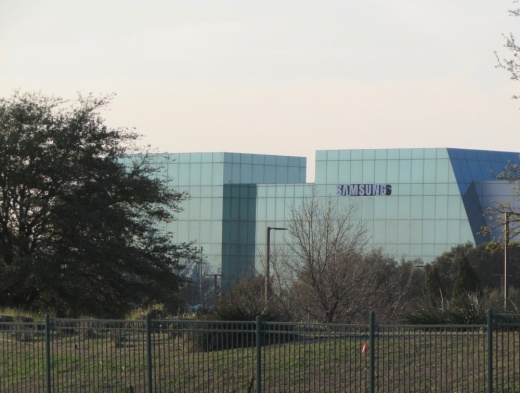Following the unprecedented discharge of several million gallons of industrial wastewater from Samsung Austin Semiconductor's Northeast Austin manufacturing plant, officials are asking how Austin can better monitor and prevent industrial mishaps in the city.
According to city staff, multiple spills involving acidic wastewater and stormwater took place at Samsung's facility at 12100 Samsung Blvd., Austin, between late 2021 and early 2022. A Texas Commission on Environmental Quality review of the situation is ongoing with oversight from the U.S. Environmental Protection Agency, and the Austin Watershed Protection Department has also been involved in response.
The first incident, identified Jan. 14 and reported to the city Jan. 18, involved the discharge of around 763,000 gallons of acidic industrial waste from the Samsung site into a Harris Branch Creek tributary. The spill may have lasted as long as 106 days. Samsung said damage to one of its sumps caused wastewater to leak into an unoccupied crawl space before flowing through a storm drain, into the facility's retention pond, and out to the waterway.
As Samsung worked to correct the fallout from that accident, heavy rainfall around the semiconductor facility resulted in two additional discharges from Samsung's stormwater pond into another nearby creek tributary to the north. The city reported a 2.2 million-gallon spill of partially treated wastewater and stormwater there Jan. 31 followed by a 5.9 million-gallon spill of the same mix Feb. 3.
In the wake of the spills, Samsung is in the process of rolling out several new controls at the chip plant aimed at preventing similar events in the future.
"Samsung Austin Semiconductor has taken immediate action to address the known issues and are performing continuous improvements which seek to find and implement solutions for potential weakness in our equipment and processes," head of communications Michele Glaze said in an email.
Creek effects
Watershed protection staff said the discharges have not posed any danger to human health. The affected waterways are isolated from residential areas and parkland, and weekly readings taken from Harris Branch Creek show no measurable effects on water quality there. However, while the northern tributary also appears unaffected by the storm-related spills, the initial monthslong discharge wiped out all aquatic life in the affected area to the south. That creek's outlook for recovery remains uncertain.
“Long-term, it’s still too early to know what the range of impacts will be for this impacted tributary. It’s likely that all algae and bacterial communities are gone, and watershed protection scientists believe it will take on the scale of six months to two years for the ecosystem network to rebuild and the stream to fully recover to a prespill condition," said Ryan Hebrink, interim division manager for environmental monitoring and compliance at the watershed office.
Since the spills, Glaze said Samsung has conducted additional cleanups along the affected creek including the removal of thousands of pounds of garbage that were found to have been illegally dumped there in the past. The company is also working on environmental remediations along the waterway.
"In partnership with our third party consultant, Arcadis, and our neighboring property owners, we will conduct ecosystem enhancements within the off-site tributary. This includes enhancing the existing habitat to promote aquatic and wildlife growth in specific areas of the tributary which will involve removal of invasive species, replanting of native species and construction of rifle, pool, glide systems within the stream," Glaze said.
City response
During a March 28 briefing to the Public Safety Committee of City Council, officials dove into the scope of the issue and strategies to ensure that similar lapses do not affect Austinites in the future. Following inquiries from District 1 Council Member Natasha Harper-Madison, who represents the area around the Samsung site, city staff said the recent discharges represent the largest industrial waste spills in Austin history.
“To our knowledge, an event of this scale has not occurred in the past," Environmental Officer Katie Coyne said.
Coyne said watershed protection staff are also reviewing best practices to improve the city's response and prepare for worse spills or contamination.
Throughout the session, council members also questioned how a discharge of hundreds of thousands of gallons of acidic waste could have taken place for nearly four months unnoticed, and why the city received notice of the incident days after state and federal regulators. According to the city, the Jan. 18 notice of the event came from the TCEQ rather than the manufacturer.
While there is "no technical requirement" to alert the city of such discharges, Hebrink said there is a need for improved communications between Austin staff and industrial sites around the city, including Samsung.
"As a courtesy, we do feel like it would have been the appropriate, right thing to do in this case," he said.
Glaze said initial reports were made at the state and national levels in line with current regulations. Samsung has now changed its response policy to include the city's watershed protection department in case of any future spills. However, Coyne also said staff do not believe the four-day reporting gap would have changed any outcomes at the creek tributary after the extended discharge.
While mainly directing questions at the Samsung situation, council members also said the accident could spark closer monitoring of industrial sites and their potential effects on residents across town.
“Part of being a tech hub is that we’re going to have to work through some of these situations as they arise and learn what steps can be taken to ensure that the residents nearby are healthy and safe," District 8 Council Member Paige Ellis said.





